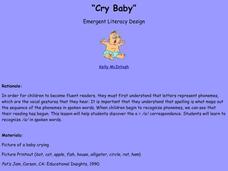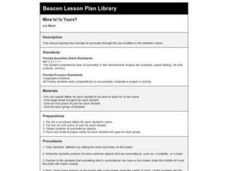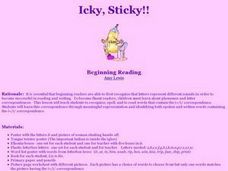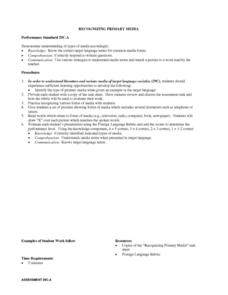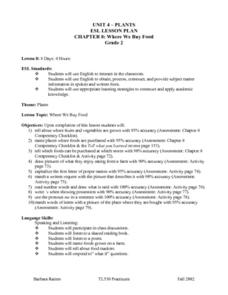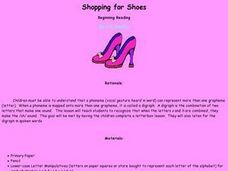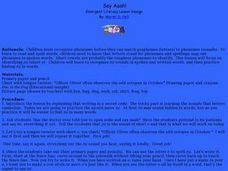Curated OER
Listen Up!
Young scholars explore the short /e/ sound. They practice writing the letter 'e' and making the short /e/ sound. They recite an 'e' tongue twister and practice finding the short /e/ sound in spoken words. They identify pictures of...
Curated OER
Cry Baby
Learners recognize the short vowel a in written and spoken language. Through matching and listening activities, they discriminate the vowel sound /a/ from other phonemes. Students associate the phoneme with its letter representation...
Curated OER
"Aaaaaa!!!!" Please Don't Cry Baby!
Learners complete a variety of activities as they examine the letter 'a' as it makes the short /a/ sound. Through instruction and modeling, they explore the sound the letter makes and how the letter is written. They recite tongue...
Curated OER
Mine Is! Is Yours?
First graders engage in a lesson which teaches the concept of symmetry through the use of letters in the student's name. They use a piece of yarn to see if they can make symmetrical pieces out of their own names.
Curated OER
Ew!!! It's Icky Sticky!
Students engage in an emergent literacy lesson plan that focuses upon the skill of phonemic awareness. The phoneme sound for the letter "i" is used with a tongue twister to build this important reading skill.
Curated OER
Cell Code
In this cell worksheet, students use the code to find out the other name for a nerve cell. Students write the letter that matches the pictures in the space above each picture.
Curated OER
Spotting Hidden Vowels
First graders recognize the short vowel i in written and spoken language. Through listening activities, they discriminate the vowel sound /i/ from other phonemes. Students associate the phoneme with its letter representation and identify...
Curated OER
Icky-Sticky
Students practice recognizing the connection between phonemes and letters with an emphasis on finding the short vowel /i/ in words. They each receive a Elkonin letterbox and a picture card with icky-sticky gum on it and the letter i.
Curated OER
Recognizing Primary Media
Students review the types of media from a previous lesson. In groups, they practice saying the new words in a foreign language. They complete a worksheet and review their answers as a class. They also match a picture of the media to...
Curated OER
Adam's Apples
Students examine the /a/ phoneme in both written and spoken words. They practice finding the /a/ in words, watch how their mouths move when making the sound, and write the letter. Next, they differentiate the sound in words, listen to a...
Curated OER
A Baby is Crying...Aaa!
Learners explore phonemes. They discuss the phoneme /a/ (short a). Students read and write words containing the phoneme /a/. They identify /a/ in written and spoken words. Learners recognize the letter symbol for /a/ and find words with...
Curated OER
Fall Secret Message Decoder Puzzle
In this vowel and consonant puzzle instructional activity, students decode the secret fall phrase by filling in the blanks with the letter that matches each picture from the box at the bottom of the page.
Curated OER
Champions Check
First graders identify consonant digraphs in written and spoken language. After a brief discussion of the combinations of /c/ and /h/ that comprise the /ch/ digraph, 1st graders practice identifying initial and final placement of the...
Curated OER
Open Wide
Students practice letter(s) map(s) along with phoneme sequences and sounds that make the /o/ sound in both spoken and written formats. They also decode words containing /o/ sounds to work towards becoming more fluent readers beginning...
Curated OER
Where We Buy Food
Second graders investigate how to buy food by going to the store. They use pictures of farming and different types of food to engage in the lesson. It includes key vocabulary that puppets use while telling a story to the students. They...
Curated OER
/o/... I can't stop yawning!
Students investigate the phoneme, a meaningful representation, and the letter symbol for /o/ (short o). This lesson helps students recognize the /o/ in spoken words and begin to spell words with the assistance of letter boxes. Students...
Curated OER
Modal Verbs and Expressions
In this modal verbs and expressions worksheet, students complete a 20 question online interactive exercise. Students choose the correct sentence to match each picture. The content is best suited for adult ESL students.
Curated OER
Casper the Cat
Students examine the letter 'a'. Through instruction and modeling and a variety of practice activities, they explore the sound the letter makes and how the letter is written. They recite tongue twisters, read stories and use letterboxes...
Curated OER
Shopping for Shoes
Students recognize that when the letters /s/ and /h/ are combined, they make the /sh/ sound. They listen for digraphs in spoken words. They practive writing the letter that makes the /sh/ sound on primary paper. They complete a worksheet...
Curated OER
ESOL Shape identification
Students review vocabulary shape cards. They match oral words of shapes with flash cards then they make and label their own set of shape flash cards and then review with a classmate.
Curated OER
Fraction Message
Young scholars practice identifying fractional parts represented in pictures and phrases. In this fraction lesson, students determine the proportion represented by common time and money phrases such as "3 hours in a day". Young scholars...
Curated OER
Say Aaah!
Pupils complete a variety of activities as they explore/review the letter 'o' as it makes the short /o/ sound. They recite short /o/ tongue twisters and practice writing the letter 'o'. They rewrite 'Skip to My Lou" using short /o/...
Curated OER
Memory Game with a Smile
Students take it in turns to say two letters and then they turn the corresponding cards around to see if the pictures/words on them match. If they do, student who has found the pair wins 1 point.
Curated OER
Dad's Fat Hat
Students complete a variety of activities as they examine the letter 'a' as it makes the short /a/ sound. Through instruction and modeling, they explore the sound the letter makes and how the letter is written. They recite tongue...

